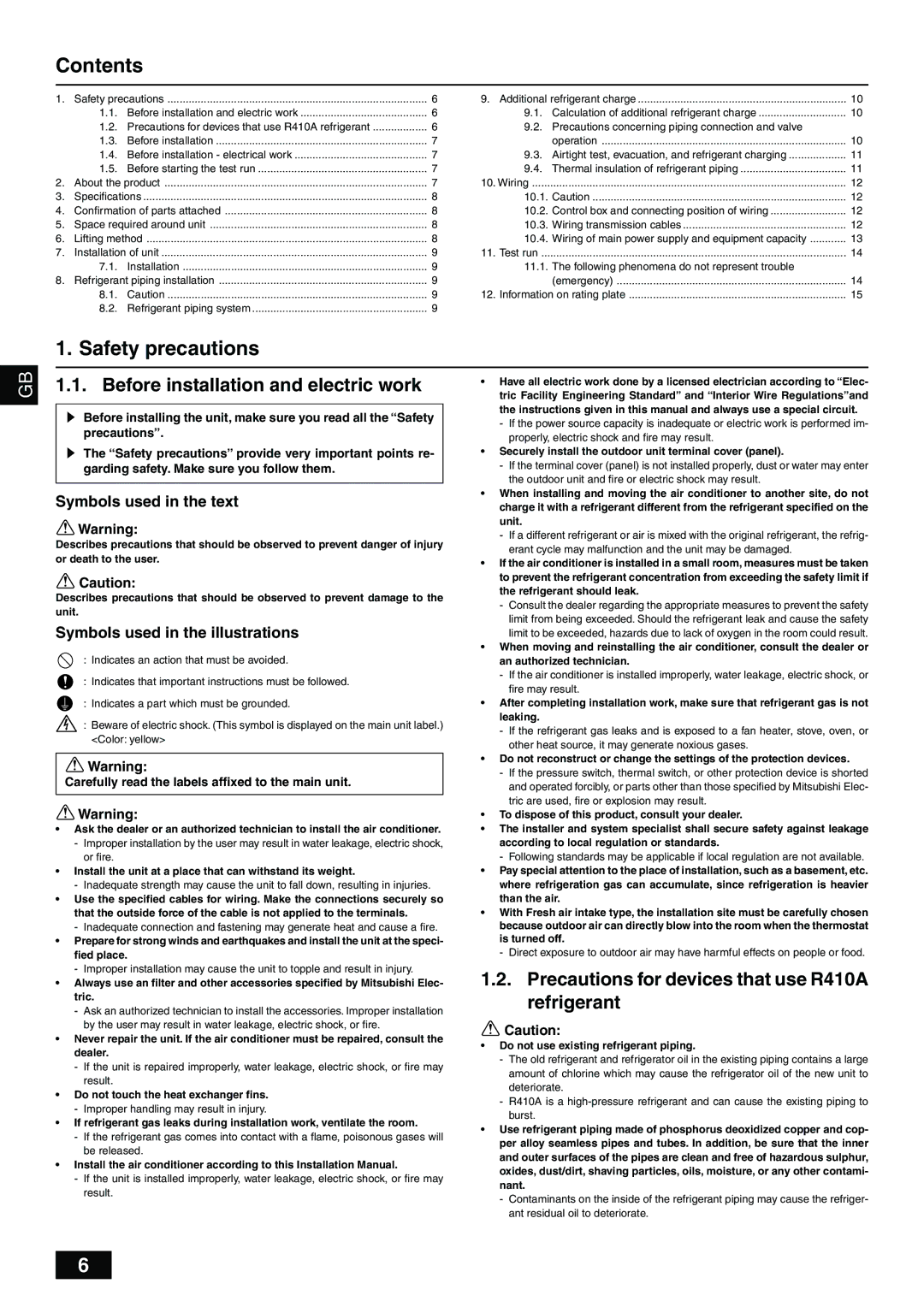1.1. Before installation and electric work
sBefore installing the unit, make sure you read all the “Safety precautions”.
sThe “Safety precautions” provide very important points re- garding safety. Make sure you follow them.
Symbols used in the text
 Warning:
Warning:
Describes precautions that should be observed to prevent danger of injury or death to the user.
 Caution:
Caution:
Describes precautions that should be observed to prevent damage to the unit.
Symbols used in the illustrations
: Indicates an action that must be avoided.
: Indicates that important instructions must be followed.
: Indicates a part which must be grounded.
 : Beware of electric shock. (This symbol is displayed on the main unit label.) <Color: yellow>
: Beware of electric shock. (This symbol is displayed on the main unit label.) <Color: yellow>
 Warning:
Warning:
Carefully read the labels affixed to the main unit.
 Warning:
Warning:
•Ask the dealer or an authorized technician to install the air conditioner.
-Improper installation by the user may result in water leakage, electric shock, or fire.
•Install the unit at a place that can withstand its weight.
-Inadequate strength may cause the unit to fall down, resulting in injuries.
•Use the specified cables for wiring. Make the connections securely so that the outside force of the cable is not applied to the terminals.
-Inadequate connection and fastening may generate heat and cause a fire.
•Prepare for strong winds and earthquakes and install the unit at the speci- fied place.
-Improper installation may cause the unit to topple and result in injury.
•Always use an filter and other accessories specified by Mitsubishi Elec- tric.
-Ask an authorized technician to install the accessories. Improper installation by the user may result in water leakage, electric shock, or fire.
•Never repair the unit. If the air conditioner must be repaired, consult the dealer.
-If the unit is repaired improperly, water leakage, electric shock, or fire may result.
•Do not touch the heat exchanger fins.
-Improper handling may result in injury.
•If refrigerant gas leaks during installation work, ventilate the room.
-If the refrigerant gas comes into contact with a flame, poisonous gases will be released.
•Install the air conditioner according to this Installation Manual.
-If the unit is installed improperly, water leakage, electric shock, or fire may result.
•Have all electric work done by a licensed electrician according to “Elec- tric Facility Engineering Standard” and “Interior Wire Regulations”and the instructions given in this manual and always use a special circuit.
-If the power source capacity is inadequate or electric work is performed im- properly, electric shock and fire may result.
•Securely install the outdoor unit terminal cover (panel).
-If the terminal cover (panel) is not installed properly, dust or water may enter the outdoor unit and fire or electric shock may result.
•When installing and moving the air conditioner to another site, do not charge it with a refrigerant different from the refrigerant specified on the unit.
-If a different refrigerant or air is mixed with the original refrigerant, the refrig- erant cycle may malfunction and the unit may be damaged.
•If the air conditioner is installed in a small room, measures must be taken to prevent the refrigerant concentration from exceeding the safety limit if the refrigerant should leak.
-Consult the dealer regarding the appropriate measures to prevent the safety limit from being exceeded. Should the refrigerant leak and cause the safety limit to be exceeded, hazards due to lack of oxygen in the room could result.
•When moving and reinstalling the air conditioner, consult the dealer or an authorized technician.
-If the air conditioner is installed improperly, water leakage, electric shock, or fire may result.
•After completing installation work, make sure that refrigerant gas is not leaking.
-If the refrigerant gas leaks and is exposed to a fan heater, stove, oven, or other heat source, it may generate noxious gases.
•Do not reconstruct or change the settings of the protection devices.
-If the pressure switch, thermal switch, or other protection device is shorted and operated forcibly, or parts other than those specified by Mitsubishi Elec- tric are used, fire or explosion may result.
•To dispose of this product, consult your dealer.
•The installer and system specialist shall secure safety against leakage according to local regulation or standards.
-Following standards may be applicable if local regulation are not available.
•Pay special attention to the place of installation, such as a basement, etc. where refrigeration gas can accumulate, since refrigeration is heavier than the air.
•With Fresh air intake type, the installation site must be carefully chosen because outdoor air can directly blow into the room when the thermostat is turned off.
-Direct exposure to outdoor air may have harmful effects on people or food.
1.2.Precautions for devices that use R410A refrigerant
 Caution:
Caution:
•Do not use existing refrigerant piping.
-The old refrigerant and refrigerator oil in the existing piping contains a large amount of chlorine which may cause the refrigerator oil of the new unit to deteriorate.
-R410A is a high-pressure refrigerant and can cause the existing piping to burst.
•Use refrigerant piping made of phosphorus deoxidized copper and cop- per alloy seamless pipes and tubes. In addition, be sure that the inner and outer surfaces of the pipes are clean and free of hazardous sulphur, oxides, dust/dirt, shaving particles, oils, moisture, or any other contami- nant.
-Contaminants on the inside of the refrigerant piping may cause the refriger- ant residual oil to deteriorate.

